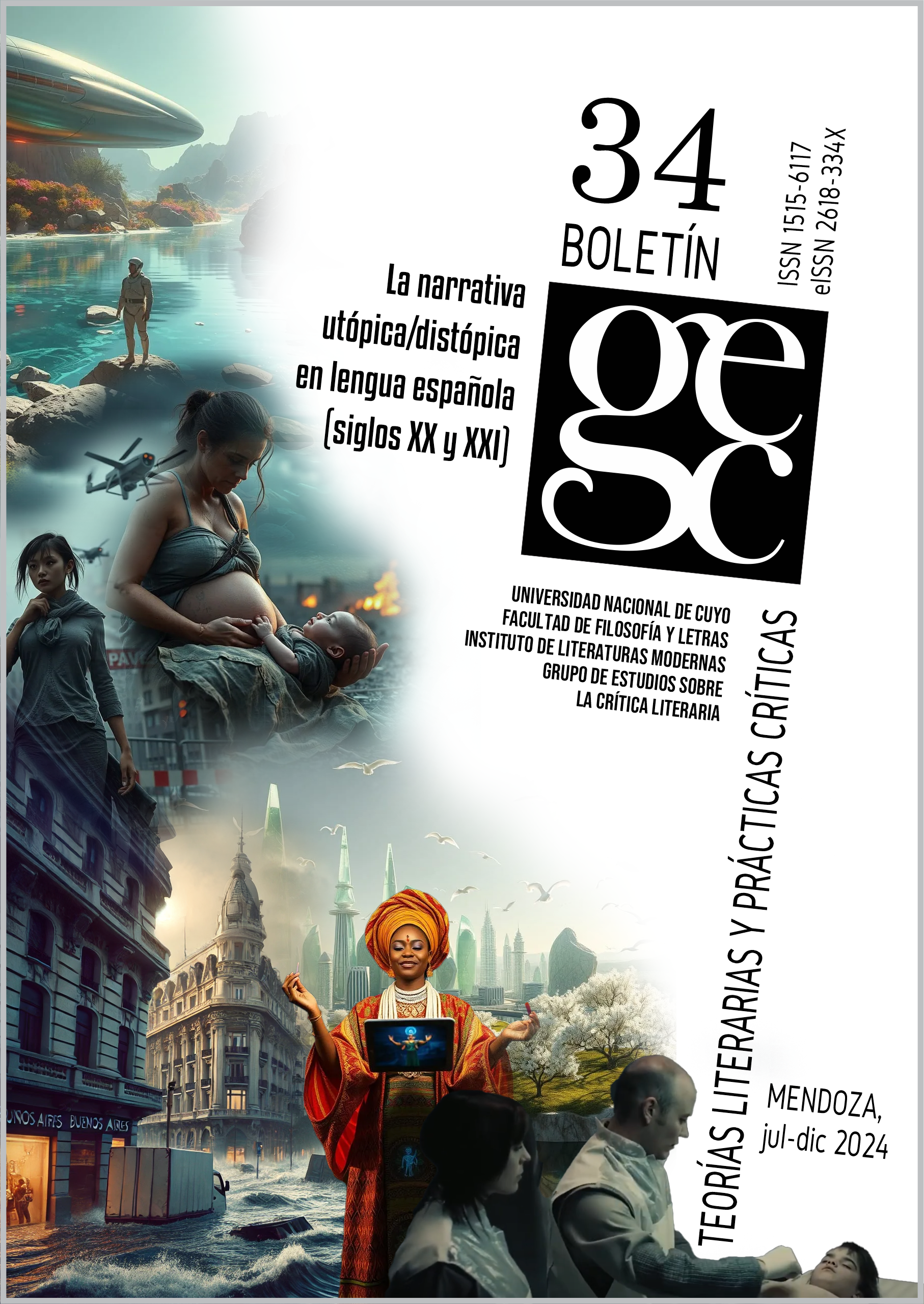About the Flood as Space, Event and Opportunity in Contemporary Argentine Science Fiction
DOI:
https://doi.org/10.48162/rev.43.069Keywords:
flood, catastrophe, bonds, dystopia, Argentine science fictionAbstract
In recent decades we find works whose plot culminates in a flood, as in the case of Berazachussetts and Los mantras modernos. We observe that the extreme climatic event could be making it possible that social organization can be reconfigured, at least as a promise towards the end of the plot. In parallel to this use of the flood motif, we find works such as Gongue and El rey del agua and El ojo y la flor in which the excessiveness of the water originates two other opposite and complementary movements in the characters. In the first case, the flood is present from the beginning of the text and is not reversed, which does not prevent the character from changing his status from passive to active. In the other two novels, what is a land full of water becomes a drought and this inversion of the predominant elements in the scenario generates what we could think of as a third space, full of mud, which produces the opening to a new bonding practice.
References
Aboaf, C. (2016). El rey del agua. Alfaguara.
Aboaf, C. (2019). El ojo y la flor. Alfaguara.
Alonso, M. (2023, enero-junio). Más allá (del regionalismo), la inundación. Confabulaciones. Revista de Literaturas de la Argentina, (9), 58-70. http://ojs.filo.unt.edu.ar/index.php/confabulaciones/issue/view/42
Ávalos Blacha, L. (2007). Berazachussetts. Entropía.
Castagnet, M. (2017). Los mantras modernos. Sigilo.
Catalin, M. y De Leone, L. (2020, septiembre). Imaginaciones territoriales para después del final (Argentina, siglo XXI). Badebec, (10), 153-160. https://rephip.unr.edu.ar/collections/21d32c51-3307-499b-89f2-399273f25b90
Cohen, M. (2012). Gongue. Interzona.
Langford, D. (2022, 22 de agosto). Cli-fi. The Encyclopedia of Science Fiction. Recuperado el 1 de octubre de 2024. https://sf-encyclopedia.com/entry/cli-fi
Pérez Gras, M. L. (2023). Utopía y distopía en el delta de la Cuenca del Plata. Confabulaciones. Revista de Literaturas de la Argentina, (9), 169-186. http://ojs.filo.unt.edu.ar/index.php/confabulaciones/issue/view/42
Sontag, S. (2008). The imagination of disaster. En A. J. Navarro (Ed.), El cine de ciencia ficción: Explorando mundos (pp. 19-49). Valdemar.(Originalmente publicado en 1966).
Torre, R. (2018). El río y la ciudad en la obra de Marcelo Cohen. Cuadernos LIRICO, (18). http://journals.openedition.org/lirico/5629
Vazquez, L. (2023, mayo). Catástrofe y vínculos: inundación y desertificación en Gongue, Quema, El rey del agua y El ojo y la flor. Chasqui, 52(1), 233-250. https://hispadoc.es/servlet/articulo?codigo=9131994
Vazquez, Lucía (2024). Los mantras modernos: posapocalipsis, futuro y desintegración. En M. Bueno, M. L. Pérez Gras, S. Jostic y L. Feuillet (Dirs.), Estéticas del DESBORDE en el siglo XXI (pp. 185-204). UADER.
Villanueva Mir, M. (2018). De la isla a la frontera. La problematización del espacio en la ficción distópica contemporánea. Tropelías. Revista de Teoría de la Literatura y Literatura Comparada, (29), 506-521. https://doi.org/10.26754/ojs_tropelias/tropelias.2018292083
Vint, S. (2021). Science fiction. The MIT P.
Žižek, S. (2014). Acontecimiento. Sextopiso.
Downloads
Published
How to Cite
Issue
Section
License
Copyright (c) 2024 Lucía Vazquez

This work is licensed under a Creative Commons Attribution-NonCommercial-NoDerivatives 4.0 International License.
Aquellos autores/as que tengan publicaciones en esta revista, aceptan los términos siguientes:
- Los autores/as conservarán sus derechos de autor y garantizarán a la revista el derecho de primera publicación de su obra, el cual estará simultáneamente sujeto a la Licencia de reconocimiento de Creative Commons que permite a terceros compartir la obra siempre que no se use para fines comerciales, siempre que se indique su autor y su primera publicación en esta revista, y siempre que se mencionen la existencia y las especificaciones de esta licencia de uso.
- Los autores/as podrán adoptar otros acuerdos de licencia no exclusiva de distribución de la versión de la obra publicada (p. ej.: depositarla en un archivo telemático institucional o publicarla en un volumen monográfico) siempre que se indique la publicación inicial en esta revista y se cumplan las otras condiciones mencionadas arriba.
- Se permite y recomienda a los autores/as difundir su obra a través de Internet (p. ej.: en archivos telemáticos institucionales o en su página web) antes y durante el proceso de envío, lo cual puede producir intercambios interesantes y aumentar las citas de la obra publicada. (Véase El efecto del acceso abierto).














